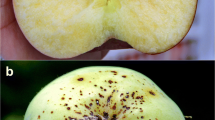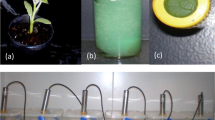Abstract
The effects of temperature, relative humidity (RH), leaf wetness and leaf age on conidium germination were investigated for Spilocaea oleagina, the causal organism of olive leaf spot. Detached leaves of five ages (2, 4, 6, 8 and 10 weeks after emergence), six different temperatures (5, 10, 15, 20, 25 and 30°C), eight wetness periods (0, 6, 9, 12, 18, 24, 36 and 48 h), and three RH levels (60, 80 and 100%) were tested. Results showed that percentage germination decreased linearly in proportion to leaf age (P < 0.001), being 58% at 2 weeks and 35% at 10 weeks. A polynomial equation with linear term of leaf age was developed to describe the effect of leaf age on conidium germination. Temperature significantly (P < 0.001) affected frequencies of conidium germination on wet leaves held at 100% RH, with the effective range being 5 to 25°C. The percent germination was 16.1, 23.9, 38.8, 47.8 and 35.5% germination at 5, 10, 15, 20 and 25°C, respectively, after 24 h. Polynomial models adequately described the frequencies of conidium germination at these conditions over the wetness periods. The rate of germ tube elongation followed a similar trend, except that the optimum was 15°C, with final mean lengths of 175, 228, 248, 215 and 135 μm at 5, 10, 15, 20 and 25°C, respectively after 168 h. Polynomial models satisfactorily described the relationships between temperature and germ tube elongation. Formation of appressoria, when found, occurred 6 h after the first signs of germination. The percentage of germlings with appressoria increased with increasing temperature to a maximum of 43% at 15°C, with no appressoria formed at 25°C after 48 h of incubation. Increasing wetness duration caused increasing numbers of conidia to germinate at all temperatures tested (5–25°C). The minimum leaf wetness periods required for germination at 5, 10, 15, 20 and 25°C were 24, 12, 9, 9 and 12 h, respectively. At 20°C, a shorter wetness period (6 h) was sufficient if germinating conidia were then placed in 100% RH, but not at 80 or 60%. However, no conidia germinated without free water even after 48 h of incubation at 20°C and 100% RH. The models developed in this study should be validated under field conditions. They could be developed into a forecasting component of an integrated system for the control of olive leaf spot.





Similar content being viewed by others
References
Azeri, T. (1993). Research on olive leaf spot, olive knot and Verticillium wilt of olive in Turkey. EPPO Bulletin, 23, 437–440.
Bentes, J. L. S., & Matsuoka, K. (2002). Histology of Colletotrichum guaranicola and Paullinia cupana var. sorbilis on resistant and susceptible clones. Fitopatologia Brasileira, 27, 71–77.
Bernès, J. (1923). Les parasites de l’olivier au congrès oleicole de Nice. Progrès Agriculture and Viticulture, 80, 518–524.
Chen, S., Zhang, J., & Zhang, L. (1981). Studies on olive peacock’s eye disease. I. Biological characteristics of the pathogen. Acta Phytopathologica Sinica, 11, 37–42.
Dzaganiya, A. M. (1967). Data on the characteristics of development of the pathogen of olive leaf spot in Georgia. Review of Applied Mycology, 46, 2788.
Graniti, A. (1993). Olive scab: a review. EPPO Bulletin, 23, 377–384.
Guechi, A., & Girre, L. (1994). Sources of Cycloconium oleaginum (Cast.) conidia for infection of olive leaves and conditions determining leaf spot disease development in the region of Sétif, Algeria. Mycopathologia, 125, 163–171.
Jetter, R., & Schäffer, S. (2001). Chemical composition of the Prunus laurocerasus leaf surface. Dynamic changes of the epicuticular wax film during leaf development. Plant Physiology, 126, 1725–1737.
Jones, A. L., Fisher, P. D., Seem, R. C., Kroon, J. C., & DeMotter, P. J. V. (1984). Development and commercialization of an in-field microcomputer delivery system for weather-driven predictive models. Plant Disease, 68, 458–463.
Kashy, A. H., Waleed, A. L., & Lewik, J. (1991). Factors affecting conidia germination of the fungus Spilocaea oleagina the causal agent of olive peacock. Arab Journal of Plant Protection, 9, 88–93.
Kolattukudy, P. E., Rogers, L. M., Li, D., Hwang, C. S., & Flaishman, M. A. (1995). Surface signalling in pathogenesis. Proceedings of the National Academy of Science, 92, 4080–4087.
Laviola, C. (1992). Problemi fitopatologici e difesa dell’olivo. La Difesa Delle Piante, 15, 101–114.
Laviola, C., & Scarito, G. (1993). Observations on spore production in Spilocaea oleagina in southern Italy. EPPO Bulletin, 23, 411–416.
López-Doncel, L. M., Viruega-Puente, J. R., & Trapero-Casas, A. (2000). Respuesta del olivo a la inoculacion con Spilocaea oleagina, agente del repilo. Boletin de Sanidad Vegetale Plagas, 26, 349–363.
MacDonald, A. J., Walter, M., Trought, M., Frampton, C. M., & Burnip, G. (2000). Survey of olive leaf spot in New Zealand. New Zealand Plant Protection, 53, 126–132.
MacHardy, W. E. (1996). Apple scab: biology, epidemiology, and management. American Phytopathological Society, St. Paul, MN.
Miehle, B. R., & Lukezic, F. L. (1972). Studies on conidial germination and appressorium formation by Colletotrichum trifolii Bain & Essary. Canadian Journal of Microbiology, 18, 1263–1269.
Mijuskovic, M. (1969). Contribution to the study of harmfulness and control of Cycloconium oleaginum, the causal agent of “peacock’s eye” of olive on the Adriatic coast of Montenegro. Review of Applied Mycology, 48, 875.
Miller, H. N. (1949). Development of the leaf spot fungus in the olive leaf. Phytopathology, 39, 403–410.
Obanor, F. O., Walter, M., Jones, E. E., & Jaspers, M. V. (2005). Sources of variation in a field evaluation of the incidence and severity of olive leaf spot. New Zealand Plant Protection, 58, 273–277.
Pinheiro, J. C., & Bates, D. M. (2000). Mixed-effects models in S and S-Plus. Springer, NY.
Pinheiro, J. C., Bates, D. M., DebRoy, S., & Sarkar, D. (2004). nlme: Linear and nonlinear mixed effects models. R package version 3. The R Foundation for Statistical Computing, Vienna, Austria.
Podila, G. K., Rogers, L. A., & Kolattukudy, P. E. (1993). Chemical signals from avocados surface wax trigger germination and appressorium formation in Colletotrichum gloeosporioides. Plant Physiology, 103, 267–272.
Prusky, D., Plumbery, R. A., & Kobiler, I. (1991). The relationship between antifungal diene levels and fungal inhibition during quiescent infection of unripe avocado fruits by Colletotrichum gloeosporioides. Plant Pathology, 40, 45–52.
R Development Core Team (2004). R: A language and environment for statistical computing. R Foundation for Statistical Computing, Vienna, Austria. Retrieved from http://www.R-project.org.
Saad, A., & Masri, S. (1978). Epidemiological studies on olive leaf spot incited by Spilocaea oleagina (Cast.) Hugh. Phytopathologia Mediterranean, 17, 170–173.
Sakamoto, Y., Ishiguro, M., & Kitagawa, G. (1986). Akaike Information Criterion Statistics. Reidel, Dordrecht, Holland.
Salerno, M. (1966). The olive leaf spot Spilocaea oleagina (Cast.) Hugh. Considerations on biology and control. Review of Applied Mycology, 45, 184.
Schwabe, W. F. S. (1979). Change in scab susceptibility of apple leaves as influenced by age. Phytophylactica, 11, 53–56.
Teviotdale, B. L., Sibbett, G. S., & Harper, D. H. (1989). Control of olive leaf spot by copper fungicides. Applied Agricultural Research, 4, 185–189.
Verona, O., & Gambogi, P. (1964). On the characteristics of oil produced by olives attacked by Cycloconium oleaginum. Agricultura Italiana, 64, 1135–1139.
Viljanen-Rollinson, S. L. H., Gaunt, R. E., Frampton, C. M. A., Falloon, R. E., & McNeil, D. L. (1998). Components of quantitative resistance to powdery mildew (Erysiphe pisi) in pea (Pisum sativum). Plant Pathology, 47, 137–147.
Wilson, E. E., & Miller, H. N. (1949). Olive leaf spot and its control with fungicides. Hilgardia, 19, 1–24.
Winston, P. W., & Bates, D. H. (1960). Saturated solutions for the control of humidity in biological research. Ecology, 41, 232–237.
Xu, X.-M., Butt, D. J., & Santen, G. (1995). A dynamic model simulating infection of apple leaves by Venturia inaequalis. Plant Pathology, 44, 865–876.
Acknowledgements
We would like to thank the New Zealand Foundation for Research, Science and Technology and the New Zealand Olive Association for funding, and Peter Alspach and Dr. Chris Frampton for their assistance in the statistical analyses.
Author information
Authors and Affiliations
Corresponding author
Rights and permissions
About this article
Cite this article
Obanor, F.O., Walter, M., Jones, E.E. et al. Effect of temperature, relative humidity, leaf wetness and leaf age on Spilocaea oleagina conidium germination on olive leaves. Eur J Plant Pathol 120, 211–222 (2008). https://doi.org/10.1007/s10658-007-9209-6
Received:
Accepted:
Published:
Issue Date:
DOI: https://doi.org/10.1007/s10658-007-9209-6




